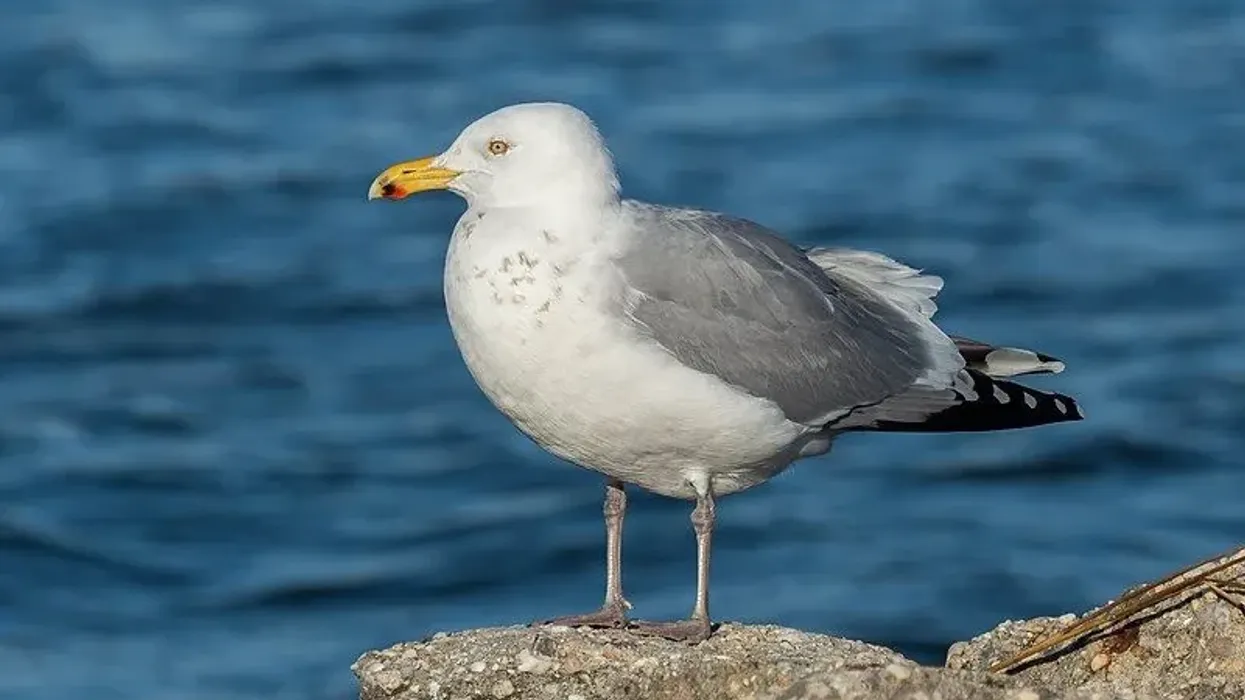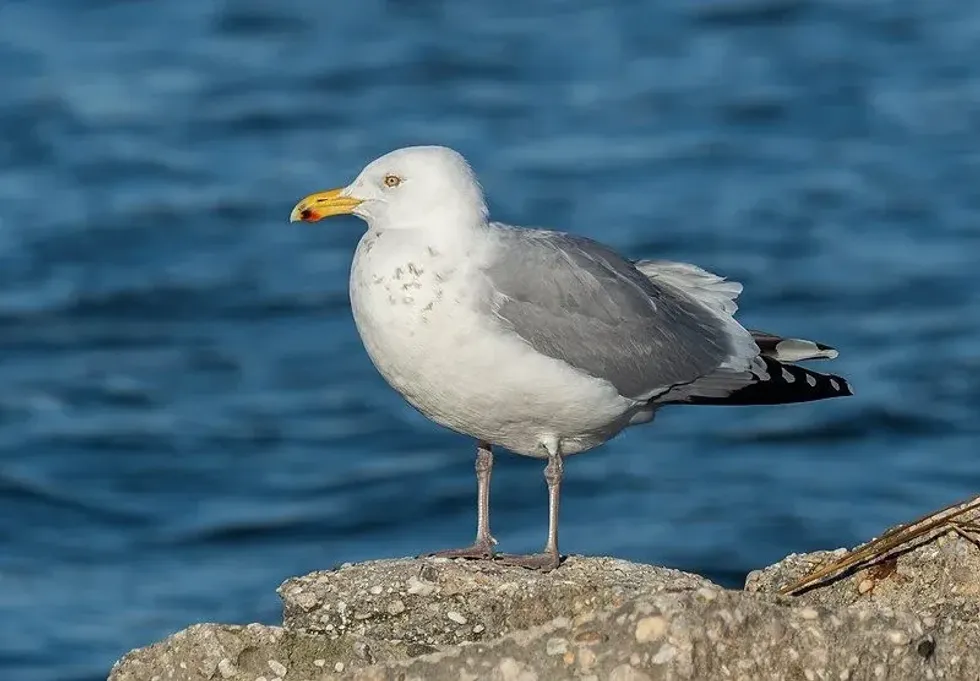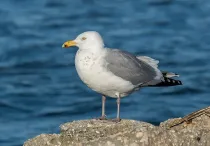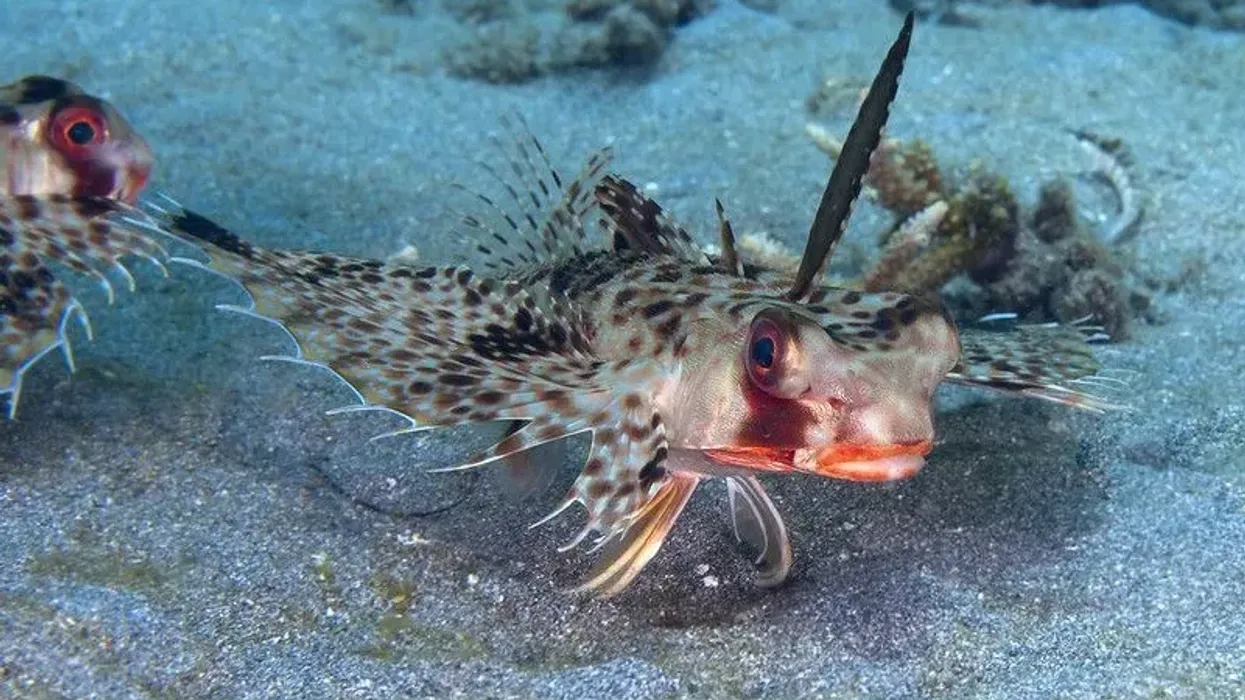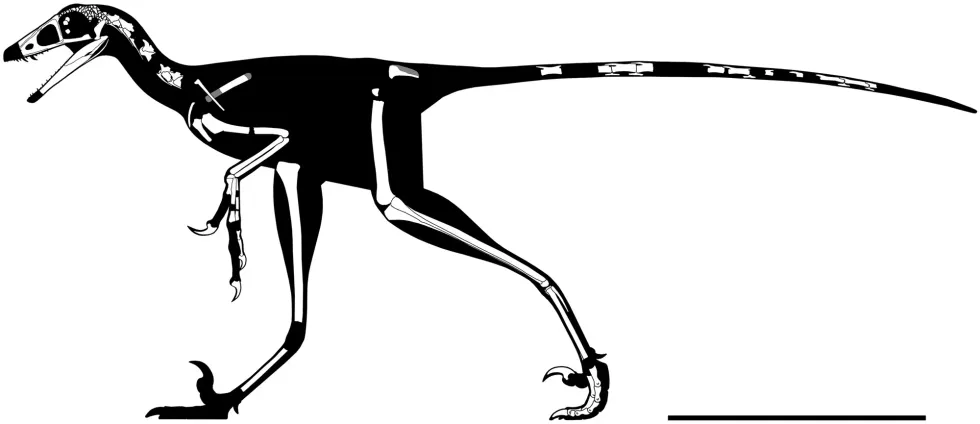An American herring gull (Larus smithsonianus) is a large gull found throughout the Northern Hemisphere, especially in North America. They are a recognized species of European herring gulls and are also known as the Smithsonian gull.
These birds were very commonly observed throughout the North American countries until the second half of the 20th century.
However in the past 40 years, the population of these North American birds has faced a significant decline throughout their range. Decreasing food supply and changing climate conditions in their natural habitats are some of the major threats that American herring gulls are experiencing within their range.
The American herring gull can breed on various types of habitats ranging from coastal areas to tundra forests and agricultural or urban landscapes. Most commonly, the gull constructs its roosting nest along the Atlantic coast or near the Great Lakes in the breeding season.
During winter migration, gulls fly away to distant coasts. Most birds fly away from the tundra forests and modified landscapes and populate the Gulf Coast in winter. Traces of vagrant populations have also been recorded inColombia, Ecuador, Peru, and Venezuela.
To know more facts about the American herring gulls, keep on reading these amazing facts. For similar content check out white tailed eagle and pink headed duck facts too.
American Herring Gull Interesting Facts
What type of animal is an American herring gull?
The American herring (Larus smithsonianus) gull is a type of large gull. It is a similar species to European herring gulls.
What class of animal does an American herring gull belong to?
The American herring gull (Larus smithsonianus) of Charadriiformes order and Laridae family belong to the class Aves, the common class for all birds.
How many American herring gulls are there in the world?
The global population of American herring gulls (Larus smithsonianus) is estimated to range between 430,000-520,000 individuals. They are following a declining population trend at present. Many recognized bird survey teams have agreed that American herring gulls require an elaborate population monitoring program for establishing an increasing population trend of this bird.
Where does an American herring gull live?
The American herring gull (Larus smithsonianus) has an extensive range map and they are distributed throughout a large extent in the northern part of North America. The breeding range of these birds lies just below the Arctic Circle in the United States and Canada.
They breed across central and south Alaska extending to the Great Lakes of the United States. Further south, the birds nest along the northeast coast of the United States where they occur throughout the stretch of southern Maine to North Carolina.
American herring gulls inhabit most parts of Canada except the lower border of the country in the south and the Arctic regions located far north. Few birds that live in the south of Alaska, the Great Lakes, and the northeast coast of the USA are residential in their range and they generally do not migrate.
However, most birds travel south along the Atlantic coast and Pacific coast in the freezing winter. Winter migration may even range as south as Mexico and Central America while some gulls move to Hawaii.
What is an American herring gull's habitat?
The American herring gull (Larus smithsonianus) prefers to inhabit a coastal habitat. They are found in small groups near water bodies preferably in inland habitats.
The gull species also nest on wet fields, rooftops, garbage dumps, lakes, and reservoirs. These birds are often observed to forage and feed at sea, lakes, rivers, and on beaches, mudflats, and fields. Inhabiting places near water fulfils their requirement of constant food supply like fish and invertebrates and also provides them shelter from their predators.
Who do American herring gulls live with?
The American herring gull (Larus smithsonianus) is a gregarious bird species that nest in spaced out colonies. Although the birds are not solitary in nature, most of their interaction with neighbor colonies seems to be forced.
They prefer to nest in very loose colonies rather than staying in tightly packed colonies. American herring gulls are very protective of their colonies and the dominant adults protect the chicks in the colonies.
How long does an American herring gull live?
The species of herring gulls (Larus smithsonianus) can live up to 30 years of age. However, most of the birds tend to die much before that in the wild due to both natural and man made causes.
How do they reproduce?
American herring gulls (Larus smithsonianus) are generally monogamous in nature with rare instances of polygamy including one male and two females in a single incubating territory. The bird pairs are formed prior to the breeding season between March and April.
They fly to their breeding nest with their respective pairs and stay there for two months. The breeding site is selected by both males and females.
The nest is formed by gathering several scrapes on the ground and is lined by vegetation on both sides.
American herring gull males do not perform any particular mating displays before breeding. The female bird approaches a male by making begging calls.
If the male responds to the begging call of the female herring gull, she flies encircling the male and produces begging calls at a higher intensity. If the female eats the food offered by the male bird during this process, it directly leads to breeding.
A female American herring gull generally lays three eggs in a breeding season at regular intervals of one to two days. The males guard the females very intensely five days before laying the eggs and during the incubation period.
The eggs hatch after an incubation period of 30-32 days from breeding. Both parents take care of the eggs and the chicks.
The young ones fly after six to seven weeks under the supervision of the parents. The parents take care of the young birds and feed them until they turn six months old.
What is their conservation status?
According to the IUCN Red List, American herring gulls (Larus smithsonianus) fall under the category of a Least Concern species. The large range map is one of the major factors that contribute to their status in the Red List. Apart from that, these birds seem to have a fairly large population currently in spite of their decreasing population trend.
The large population of the American herring gull and their extremely vast range do not let them fall under the threshold of endangered species. However, these birds face some significant threats that are likely to affect their population trend.
American Herring Gull Fun Facts
What do American herring gulls look like?
The American herring gull is a large gull with a heavy build found in the northern parts of North America. They have a large and strong bill with a fuller rump.
In breeding plumage, these birds have white underparts. The head, rump, and tail are also fully covered in white feathers in adult plumage. Adults have a powerful yellow bill with a red spot on the lower mandible.
The red spot is only visible from up close. The upper part of the body is covered with pale gray feathers. The pale gray color continues to the upper wings of the herring gull.
Adults have black wingtips with white spots known as mirrors on them. The underpart of the wings also has pale gray feathers with dark edges.
In the winter plumage, the adults develop brown stripes on the neck and head. They have pale yellow eyes bordered by an orange ring and pale pink legs.
The young herring gulls have mottled brown feathers for the first four years. They take four years to reach adult plumage. In the first winter, the juveniles have a gray brown plumage, brownish legs, and a dark bill.
In the second winter, their plumage becomes paler and they begin to show some amount of gray. By the third winter, they start to resemble the adults with very few brown feathers on the legs and tail.

How cute are they?
Undoubtedly, an adult American herring gull looks quite cute and graceful. The yellow bill brightens up its face.
How do they communicate?
The American herring gull communicates through vocalizations. They have seven to eight types of calls, each of them used for different actions.
How big is an American herring gull?
The length of American herring gulls ranges between 21-26 in (53-66 cm). They are slightly larger than the ring-billed gull.
How fast can an American herring gull fly?
The speed of the American herring gull has not been determined.
How much does an American herring gull weigh?
The weight of an American herring gull ranges between 1.3-3.6 lb (600-1650 g).
What are the male and female names of the species?
Male and the female birds of this species are referred to as cocks and hens.
What would you call a baby American herring gull?
A baby herring gull is called a chick.
What do they eat?
The American herring gull is carnivorous in nature and their food habit varies with changing season. Some common food items that are included in the diet of the American herring gull are birds, chicks, eggs, and invertebrates like sea urchins, clams, mussels, crabs, and squid.
They also feed on small fish like capelin, smelt, and alewife. They are observed scavenging garbage dumps.
Are they dangerous?
No, American herring gulls are not dangerous.
Would they make a good pet?
Although you will often find these birds trying to nest on rooftops, they do not adapt well once they are inside the house.
Did you know...
In polygamous herring gull couples, the chances of impregnating the secondary female are very low. Only the primary female can give birth to the chicks.
What is the difference between a seagull and a herring gull?
The seagull is not any particular species of gulls, rather it is an informal way of referring to all the species of the Laridae family collectively. Herring gulls are one such species of the Laridae family that are popularly known as seagulls in America.
There are some other species like the great black backed gull, lesser black backed gull, and black headed gull that also fall under the category of seagulls.
Are herring gulls endangered?
Though it is true that the population of the herring gulls is declining continuously within their range for various reasons, they are still not considered to be endangered.
Here at Kidadl, we have carefully created lots of interesting family friendly animal facts for everyone to discover! Learn more about some other birds from our dove facts and Rofous hummingbird facts pages.
You can even occupy yourself at home by coloring in one of our free printable herring gull coloring pages.

